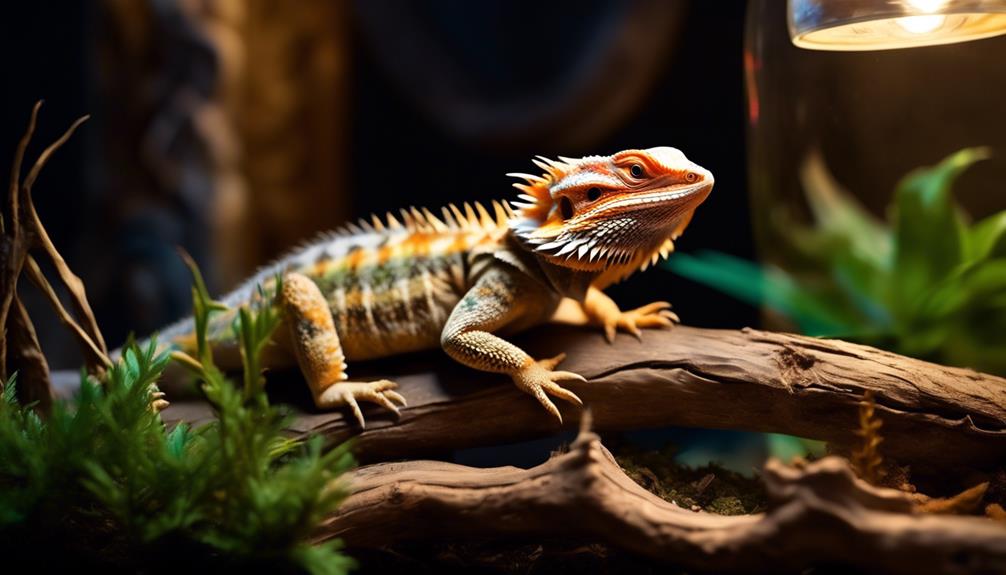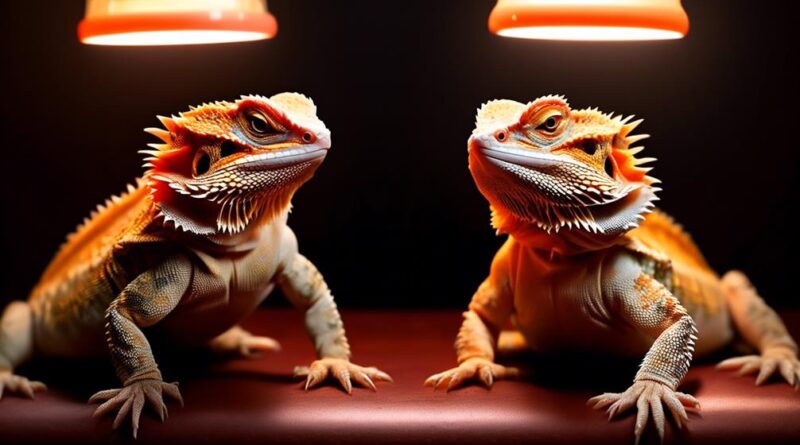Understanding Bearded Dragon Behavior and Socializing Tips
Owning a bearded dragon can be like unlocking a secret world of fascinating behaviors and interactions. From their subtle body language to the way they communicate, these unique creatures have a lot to say if you know how to listen.
But understanding and socializing with bearded dragons requires more than just admiration from a distance. It's about decoding their cues and creating a bond that goes beyond the glass of their terrarium.
As you navigate the intricacies of bearded dragon behavior and socialization, you'll find that there's much more to these reptiles than meets the eye.
Bearded Dragon Behavior Patterns
Understanding bearded dragon behavior patterns can help you better care for and interact with your pet. When it comes to breeding behavior, male bearded dragons often display head bobbing, arm waving, and even darkening of their beard to show their dominance and attract potential mates. On the other hand, female bearded dragons may exhibit a receptive posture and may even dig in the substrate to prepare for egg-laying. It's crucial to understand these behaviors to provide a suitable environment for breeding or to prevent unwanted breeding.
Communication signals are also an essential aspect of bearded dragon behavior. These reptiles use various signals to communicate with each other and their human caregivers. Head bobbing, for instance, isn't only a mating behavior but also a way for bearded dragons to show dominance or submission. Additionally, they may use arm waving as a sign of submission or to display their readiness to interact. Understanding these communication signals can help you interpret your pet's mood and respond appropriately, fostering a deeper bond between you and your bearded dragon.
Understanding Bearded Dragon Body Language
Male bearded dragons often display head bobbing, arm waving, and even darkening of their beard to show their dominance and attract potential mates. When observing their body language, these behaviors offer valuable insights into their mood and intentions. Interpreting these signals is crucial for understanding your bearded dragon's state of mind and for successful socializing.
Head bobbing is a common behavior seen in male bearded dragons and can signal both dominance and aggression. This movement is often accompanied by a darker beard and a puffed-up body, indicating a territorial display.
On the other hand, arm waving is a submissive signal, often seen in response to a perceived threat or during courtship.
It's essential to recognize the context in which these behaviors occur to accurately interpret your bearded dragon's body language. Additionally, observing their body language can guide you in creating a comfortable and stress-free environment for your pet.
When socializing with other bearded dragons, understanding their body language can prevent potential conflicts and promote positive interactions. By paying attention to their signals, you can provide appropriate socializing opportunities that cater to their natural behaviors.
Socializing Bearded Dragons: Do's and Don'ts
When it comes to socializing your bearded dragon, there are several important do's and don'ts to keep in mind.
First, do use positive reinforcement when interacting with your bearded dragon. This can include offering treats and verbal praise to encourage positive behaviors. Positive reinforcement helps your bearded dragon feel more comfortable and confident during socialization.
Additionally, do practice gentle handling techniques. When handling your bearded dragon, support its body properly and avoid sudden movements to prevent stress or injury.
On the other hand, there are also important don'ts to consider.
Don't force socialization. If your bearded dragon seems stressed or uninterested in interacting, it's crucial to respect its boundaries and give it space. Forcing socialization can lead to fear and anxiety in your pet.
Furthermore, don't punish your bearded dragon during socialization attempts. Punishment can create a negative association with socializing and damage the bond between you and your pet.
Recognizing Signs of Stress in Bearded Dragons
Recognizing signs of stress in bearded dragons is crucial for maintaining their well-being and ensuring a positive socialization experience. Being aware of the indicators of stress in your bearded dragon will help you create a comfortable and safe environment for them.
Here are some key stress indicators to watch for:
- Changes in Color: Bearded dragons may darken or lighten their skin color when stressed.
- Puffing Up: If your bearded dragon puffs up its beard and body, it could be a sign of stress.
- Hiding or Avoidance: When your dragon consistently hides or avoids interactions, it may be feeling stressed.
- Aggression: Uncharacteristic aggression towards you or other dragons can indicate stress.
To ensure your bearded dragon's well-being, it's important to employ stress management techniques. Providing ample hiding spots, maintaining a consistent environment, and minimizing sudden loud noises can help reduce stress. Additionally, ensuring their habitat is properly sized, offering a balanced diet, and handling them gently can contribute to their overall comfort and well-being.
Creating a Comfortable Environment for Socializing
When creating a comfortable environment for socializing with your bearded dragon, it's essential to prioritize their safety and comfort above all else. Creating trust is crucial for a positive socialization experience. Start by setting up a designated area for interaction that's secure and free from potential hazards. This space should be a familiar and safe environment for your bearded dragon, helping to establish a sense of security and reduce stress. Adequate lighting and temperature control are also essential for their well-being.
Positive reinforcement plays a significant role in building trust and comfort during socialization. Offer treats and favorite foods to encourage positive associations with interaction. Be patient and gentle, allowing your bearded dragon to approach you at their own pace. Avoid sudden movements or loud noises that could startle them. Consistency in your interactions will help them feel at ease and build trust over time.
Incorporate objects and accessories within the socialization area that your bearded dragon enjoys, such as rocks, branches, or hiding spots. Familiar scents and textures can provide comfort and a sense of security. Additionally, maintaining a regular schedule for socialization can help establish a routine, allowing your bearded dragon to anticipate and feel more comfortable with interaction.
Introducing Bearded Dragons to Each Other
To introduce bearded dragons to each other, carefully monitor their initial interactions to ensure a smooth and safe introduction. Introducing bearded dragons to one another can be a delicate process, as their social interaction and behavior dynamics play a significant role in their group dynamics. Here are some essential tips to consider when introducing bearded dragons to each other:
- Start with Separate Enclosures: Keep the new bearded dragon in a separate enclosure initially to allow both dragons to become accustomed to each other's presence without direct interaction.
- Supervised Interaction: When you decide to introduce them, always supervise their interactions closely to ensure they're getting along and not displaying any aggressive behavior.
- Provide Multiple Hiding Spots: Having plenty of hiding spots in the enclosure will allow each bearded dragon to have their own space and retreat if they feel overwhelmed.
- Watch for Body Language: Pay attention to their body language, such as head bobbing, puffing up, or aggressive posturing, which may indicate discomfort or potential conflict.
Bearded Dragon Playtime and Interaction

After introducing bearded dragons to each other, it's important to understand how to facilitate their playtime and social interactions within the enclosure. Bonding activities and enrichment ideas are essential for promoting healthy interactions between your bearded dragons. Providing various climbing structures, hiding spots, and toys can encourage exploration and play. Additionally, incorporating live food enrichment, such as crickets or mealworms, can stimulate natural hunting behaviors and promote engagement.
When it comes to handling techniques and training tips, it's crucial to ensure that your bearded dragons feel comfortable and secure during interactions. Start by gently handling them for short periods, gradually increasing the duration as they become more accustomed to being held. Always support their bodies and avoid sudden movements to prevent stress or injury. Using positive reinforcement, such as offering treats or gentle praise, can help them associate handling with positive experiences.
Training your bearded dragons to respond to cues, such as hand targeting or recall, can also enhance their mental stimulation and strengthen the bond between you. By using rewards and repetition, you can teach them simple commands and create interactive experiences. Remember to be patient and consistent, as each dragon may have different learning paces.
Monitoring Bearded Dragon Socialization Progress
You can assess the progress of your bearded dragons' socialization by observing their interactions and body language in their shared environment. Monitoring their socialization progress is essential for understanding their behavioral changes and the environmental impact on their interactions.
Here are some key indicators to help you evaluate the socialization progress of your bearded dragons:
- Body Language: Pay attention to their body language during interactions. Are they displaying signs of stress or aggression, such as puffing up their beard, darkening their color, or showing defensive behaviors?
- Feeding Behavior: Observe how they behave during feeding time. Do they eat peacefully together, or is there competition and aggression over food?
- Space Utilization: Take note of how they utilize their shared space. Are they comfortable basking, exploring, or resting near each other, or do they tend to avoid each other?
- Communication: Look for signs of communication between the bearded dragons. Do they engage in any non-aggressive communication, such as head bobbing or arm waving?
Frequently Asked Questions
Can Bearded Dragons Be Trained to Perform Tricks or Commands?
Yes, bearded dragons can be trained to perform tricks or commands using positive reinforcement training methods. This can be effective by observing their behavioral cues and understanding their motivation. Consistency and patience are key.
How Do Bearded Dragons Communicate With Each Other in the Wild?
In the wild, bearded dragons communicate through body language, such as head bobbing, arm waving, and puffing up. They use these behaviors to establish dominance, attract mates, and signal aggression or submission. Understanding these cues is vital for socializing techniques.
Do Bearded Dragons Have a Preferred Social Hierarchy Within Their Groups?
Bearded dragons do establish a dominance hierarchy within their groups. Social interaction and dominance displays are common as they establish and maintain their positions within the group. Understanding group dynamics is important for caring for multiple dragons.
Can Bearded Dragons Form Strong Bonds With Their Human Owners?
Yes, bearded dragons can form strong bonds with their human owners through consistent human interaction, trust building, and socializing techniques. They will recognize and respond to your presence, creating a meaningful bond over time.
Are There Any Specific Activities or Toys That Can Help Improve a Bearded Dragon's Socialization Skills?
To improve your bearded dragon's socialization skills, engage in interactive playtime and behavioral training. Incorporate enrichment toys and socialization activities into their routine to promote bonding and mental stimulation, enhancing their overall well-being.
Conclusion
Now that you understand the behavior and body language of bearded dragons, you can confidently socialize with them.
Remember to be patient and respectful of their boundaries, and always monitor their stress levels.
Create a comfortable environment for socializing and introduce them to each other slowly.
With time and positive interaction, your bearded dragons will flourish and enjoy their playtime with you.
Keep learning and observing their socialization progress to ensure a happy and healthy relationship with your reptile friends.
